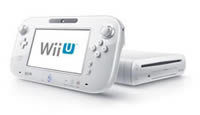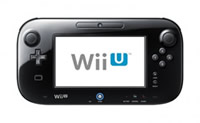Electronic Corner
There's big news coming from Japan with the release of the Wii U so I'm going to do a special report and trip down memory lane in dedication to Nintendo, a company that's dear to our hearts along the bumpy road of video game history.
Wii U
Last week was an important one for good old Nintendo as they finally released their much anticipated new console, the Wii U. Nintendo promised a completely new way to play games but, did they deliver? Well, not quite (yet).
 The Console
The Console
The Wii U was released November 18th and came in two version, Basic (white) and Deluxe (black). Basic gives you a 8GB harddrive and is aimed more towards casual games and families with small children. The Deluxe on the other hand is an invitation to big gamers to come back to Nintendo. Packed with a 32GB harddrive, a GamePad standing charger, Nintendoland and bonus features that will come available to them in the future, this is how Nintendo plans to steal back the hardcore gamers after so many lost faith after the Wii. But does it succeed? I'll get to that soon.
 The Gamepad
The Gamepad
The Wii U's main gimmick is the GamePad, a tablet-sized controller with a 6.2" screen that's supposed to change the way we play games. Some games utilize the GamePad for displaying inventory while others use it as a game-changer such as in Super Mario Bros. U, where the player can add and remove platforms to either help fellow players or make them fall to their demise. A great feature of the GamePad is that it allows you to move the gameplay solely onto it leaving the TV available to use by others. This doesn't make it a portable game console since it has to be in range of the console. The battery life of the GamePad is rather poor unfortunately clocking in about 4 or 5 hours of use before it needs recharging
The Verdict
Nintendo promised this would revolutionize how people play games but it has yet to deliver. The launch titles are a mixed bag and only show the tip of the iceberg of the GamePad's potential. NintendoLand is a collection of mini-games that all focus on a neat design of the GamePad giving players a good idea of what to expect and as I mentioned before, Super Mario Bros. U has the GamePad user either helping or hindering other players. All this has still left something to be desired for many, but don't fret! The Wii U has been only for merely a week and the good games have yet to start flowing in. Nintendo has always been innovative so we should expect the exclusives to utilize the GamePad in clever ways and hope that third-party developers pull some tricks to make gamers buy cross-platform games solely on the Wii U.
For a preview of some of new games and a taste of things to come, watch this!
Nostalgia
Now while we're celebrating the release of the Wii U (despite its problems), let's take a trip down memory lane and look at their very first console, the NES. I think Nintendo is important to many my age because we all grew up on it. Those who are a bit older are still passionate about the good ol' 8-bit days and it's alive and well nowadays because of them.
Nintendo Entertainment System (NES)
Nintendo's first gaming console came out in Japan in 1983 and was originally called Super Famicon. When Nintendo brought it over to America in 1985 it was renamed to Nintendo (Entertainment System) or as its more commonly known as, NES. It captivated the hearts of youths with bright 8-bit graphics and tunes while punished them with arguably the hardest games in gaming history. The NES also paved the way with games for some of the best Nintendo-exclusives we have today such as Super Mario Bros., Donkey Kong, Zelda, Metroid and more. Not to mention other classics such as Castlevania, Final Fantasy, Ninja Gaiden and a many, many more.
The 8-bit style didn't die out when Nintendo carried to the 16-bit generation. The use of 8-bit graphics and sounds are employed in modern indie games
along. Even in modern electronic music, the use of 8-bit strikes a nostalgic chord in many.
Now for that trip down memory lane:
-Stan Chenderovitch

